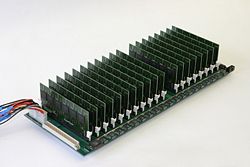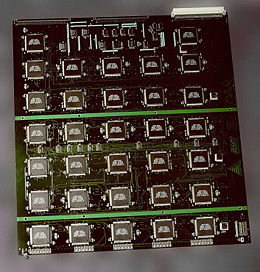Brute force attack
2008/9 Schools Wikipedia Selection. Related subjects: Cryptography
In cryptanalysis, a brute force attack is a method of defeating a cryptographic scheme by trying a large number of possibilities; for example, exhaustively working through all possible keys in order to decrypt a message. In most schemes, the theoretical possibility of a brute force attack is recognized, but it is set up in such a way that it would be computationally infeasible to carry out. Accordingly, one definition of "breaking" a cryptographic scheme is to find a method faster than a brute force attack.
The selection of an appropriate key length depends on the practical feasibility of performing a brute force attack. By obfuscating the data to be encoded, brute force attacks are made less effective as it is more difficult to determine when one has succeeded in breaking the code.
The brute force attack could be combined with a dictionary attack.
Symmetric ciphers
For symmetric-key ciphers, a brute force attack typically means a brute-force search of the key space; that is, testing all possible keys in order to recover the plaintext used to produce a particular ciphertext.
In a brute force attack, the expected number of trials before the correct key is found is equal to half the size of the key space. For example, if there are 264 possible keys, a brute force attack would, on average, be expected to find a key after 263 trials.
For each trial of a candidate key the attacker needs to be able to recognize when he has found the correct key. The most straightforward way is to obtain a few corresponding plaintext and ciphertext pairs, that is, a known-plaintext attack. Alternatively, a ciphertext-only attack is possible by decrypting ciphertext using each candidate key, and testing the result for similarity to plaintext language — for example, English encoded in ASCII.
In general, a symmetric key cipher is considered secure if there is no method less expensive (in time, memory requirements, etc) than brute force; Claude Shannon used the term "work factor" for this.

Symmetric ciphers with keys of length up to 64 bits have been broken by brute force attacks. DES, a widely-used block cipher which uses 56-bit keys, was broken by custom hardware in 1998 (see EFF DES cracker), and a message encrypted with RC5 using a 64-bit key was broken more recently by Distributed.net. More recently, the COPACOBANA (Cost-Optimized Parallel COde Breaker) was built, which is a reconfigurable code breaker that is suited for key searching of many different algorithms, including DES. In addition, it is commonly speculated that government intelligence agencies (such as the U.S. NSA) can successfully attack a symmetric key cipher with long key lengths, such as a 64-bit key, using brute force. For applications requiring long term security, 128 bits is, as of 2004, currently thought a sufficient key length for new systems using symmetric key algorithms. NIST has recommended that 80-bit designs be phased out by 2015.
If keys are generated in a weak way, for example, derived from a guessable- password, it is possible to exhaustively search over a much smaller set, for example, keys generated from passwords in a dictionary. See password cracking and passphrase for more information.
Ciphers with proven perfect secrecy, such as the one-time pad, cannot be broken by a brute force attack.
Theoretical limits
The resources required for a brute force attack scale exponentially with increasing key size, not linearly. Doubling key size does not double the required number of operations, but rather squares the number of required operations. Thus, although 56 bit keys, such as those used by the obsolete Data Encryption Standard (DES) are now quite practical to attack by brute force, this is not true of much longer keys, such as those used by the more modern Advanced Encryption Standard (AES), which uses keys of at least 128 bits in length.
There is a physical argument that a 128 bit key is secure against brute force attack. The so-called Von Neumann-Landauer Limit implied by the laws of physics sets a lower limit on the energy required to perform a computation of ln(2)kT per bit erased in a computation, where T is the temperature of the computing device in kelvin, k is the Boltzmann constant, and the natural logarithm of 2 is about 0.693. No irreversible computing device can use less energy than this, even in principle.
Thus, in order to simply flip through the possible values for a 128-bit key (ignoring doing the actual computing to check it), one would need a device consuming at a minimum 10 gigawatts (about the equivalent of eight large, dedicated nuclear reactors) running continuously for 100 years. The full actual computation—checking each key to see if you have found a solution—would consume many times this amount.
However, this argument assumes that the register values are changed using conventional set and clear operations which inevitably generate entropy. It has been shown that computational hardware can be designed not to encounter this theoretical obstruction: see reversible computing. It should be pointed out that no known such computers have been constructed.
The amount of time required to break a 128 bit key is also daunting. Each of the 2128 possibilities must be checked. This is an enormous number, 340,282,366,920,938,463,463,374,607,431,768,211,456 in decimal. A device that could check a billion billion keys (1018) per second would still require about 1013 years to exhaust the key space. This is longer than the age of the universe, which is about 13,000,000,000 ( ) years.
) years.
AES permits the use of 256 bit keys. Breaking a 256 bit key by brute force requires 2128 times more computational power than a 128 bit key. A device that could check a billion billion (1018) AES keys per second would require about  years to exhaust the 256 bit key space.
years to exhaust the 256 bit key space.
Hence, 128 bit keys are impractical to attack by brute force methods using current technology and resources, and 256 bit keys are not likely to be broken by brute force methods using any obvious future technology.
Unbreakable codes
Certain types of encryption, by their mathematical properties, cannot be defeated by brute force. An example of this is one-time pad cryptography, where every bit has a corresponding key bit. A brute force attack would eventually reveal the correct decoding, but also every other possible combination of bits, and would have no way of distinguishing one from the other.
For example, a small 100 byte one-time pad encoded string subjected to a brute force attack would eventually reveal every 100 byte string possible, including the correct answer, but mostly nonsense. Of all the answers given, there is no way of knowing which is the correct one.
